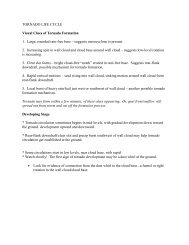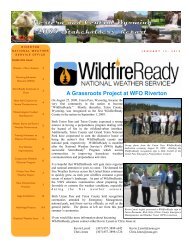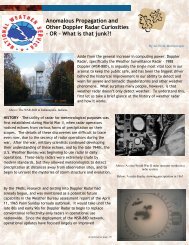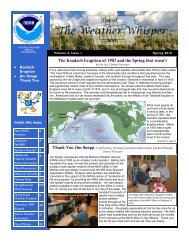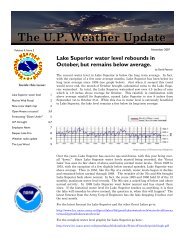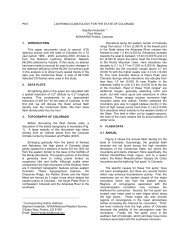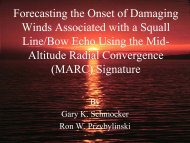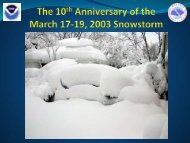Rainfall Totals from the Hermosa Flash Flood of 17 August 2007
Rainfall Totals from the Hermosa Flash Flood of 17 August 2007
Rainfall Totals from the Hermosa Flash Flood of 17 August 2007
You also want an ePaper? Increase the reach of your titles
YUMPU automatically turns print PDFs into web optimized ePapers that Google loves.
percent average that Maddox et al. (1979) found in his summary <strong>of</strong> western flash flood events.<br />
Maddox et al. (1980) categorized flash flood events in <strong>the</strong> western United States into four<br />
categories. This event fits into <strong>the</strong> Type II category as it corresponds well with <strong>the</strong> synoptic<br />
pattern including westerly winds al<strong>of</strong>t and observed precipitable water values <strong>of</strong> around 70 to 75<br />
percent <strong>of</strong> <strong>the</strong> maximum for that time <strong>of</strong> year.<br />
Doswell et al. (1996) put toge<strong>the</strong>r a comprehensive list <strong>of</strong> ingredients to assist <strong>the</strong><br />
forecaster in flash flood situations. The analysis above is consistent with <strong>the</strong> factors <strong>the</strong>y<br />
reviewed including deep moist convection and sustained high rainfall rates which are described<br />
in <strong>the</strong> following section.<br />
3. Observations<br />
3.1 Radar Estimates<br />
At 2330 UTC <strong>17</strong> <strong>August</strong> <strong>the</strong> first storm cell developed west <strong>of</strong> <strong>Hermosa</strong> (Fig. 19). This<br />
cell had moved past <strong>Hermosa</strong> by 2350 UTC. Ano<strong>the</strong>r smaller cell developed at 2350 UTC and<br />
moved past <strong>Hermosa</strong> by 0015 UTC. At that time <strong>the</strong> main cell was beginning to develop west <strong>of</strong><br />
<strong>Hermosa</strong>. This cell developed reflectivities in excess <strong>of</strong> 70 dBZ (Fig. 20) and remained nearly<br />
stationary west <strong>of</strong> <strong>Hermosa</strong> until 0100 UTC concentrating an area <strong>of</strong> precipitation with high<br />
rainfall rates directly over <strong>the</strong> area that would soon be flooded. Exacerbating <strong>the</strong> situation, at<br />
0100 UTC <strong>the</strong> area around <strong>Hermosa</strong> began to fill with echoes (Fig. 21) and <strong>the</strong>se echoes<br />
remained over this same area until about 0245 UTC. The final wave <strong>of</strong> showers for <strong>the</strong> evening<br />
crossed <strong>Hermosa</strong> <strong>from</strong> about 0300 to 0330 UTC.<br />
Precipitation estimates generated <strong>from</strong> <strong>the</strong> KUDX radar data using a convective Z-R<br />
relationship (Z=300R 1.4 ) indicated an area <strong>of</strong> 2 inches or more <strong>of</strong> rain fell <strong>from</strong> Custer to Red<br />
Shirt to approximately 10 miles north <strong>of</strong> <strong>Hermosa</strong> (Fig. 22). An area <strong>of</strong> 36 mi 2 centered around<br />
<strong>Hermosa</strong> received 5 to 6 inches <strong>of</strong> rain according to this estimate. When looking at <strong>the</strong> radarestimated<br />
precipitation using a tropical Z-R relationship (Z=250R 1.2 ), <strong>the</strong> area that received<br />
greater than 2 inches <strong>of</strong> rain increased slightly and <strong>the</strong> maximum rainfall detected increased <strong>from</strong><br />
5 to 6 inches to 8 to 9 inches just north <strong>of</strong> <strong>Hermosa</strong> (Fig. 23). Because <strong>of</strong> <strong>the</strong> poor performance<br />
<strong>of</strong> <strong>the</strong> tropical Z-R relationship it will not be discussed fur<strong>the</strong>r in this paper.<br />
3.2 <strong>Rainfall</strong> Reports<br />
In <strong>the</strong> weeks following <strong>the</strong> flood, <strong>the</strong> United States Geological Survey (USGS)<br />
approached <strong>the</strong> NWS to ensure rainfall amounts were documented. The USGS provided <strong>the</strong><br />
NWS with a list <strong>of</strong> rainfall reports that were collected <strong>from</strong> <strong>the</strong> general public with <strong>the</strong>ir flood<br />
survey. The NWS contacted <strong>the</strong> individuals, visited most <strong>of</strong> <strong>the</strong>ir locations, and documented <strong>the</strong><br />
rainfall and rain gage data. These reports, combined with existing rainfall reports, were used to<br />
produce an isohyetal map <strong>of</strong> <strong>the</strong> storm rainfall (Fig. 24). According to <strong>the</strong> available rainfall data,<br />
a maximum storm value <strong>of</strong> 10.50 inches <strong>of</strong> rain fell five miles west-northwest <strong>of</strong> <strong>Hermosa</strong>. An<br />
area <strong>of</strong> approximately 20 mi 2 received at least 6 inches <strong>of</strong> rain, while an area <strong>of</strong> about 1 mi 2<br />
received at least 10 inches <strong>of</strong> rain.<br />
3




